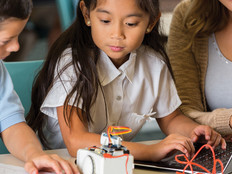How Virtual Teaching Helps Remote K–12 School Districts
These days, the talk of “haves” and “have nots” in K–12 education usually revolves around technology and access to high-speed internet connections. While the digital divide and homework gap are still issues for many districts, some schools are facing a lack of qualified teachers.
APM Reports highlights a district in West Virginia, where qualified teachers are leaving in droves and being replaced by substitutes who aren’t as familiar with the topics they are being asked to teach.
This troubling trend is becoming prevalent in other isolated districts as well. But some schools are being innovative when recruiting educators by turning to videoconferencing and collaboration tools to employ virtual teachers.
Videoconferencing Brings In Teachers from Anywhere
When a Georgia school district was faced with long-term vacancies, the school board decided to set up a short-term solution of livestreaming educators from an online education provider in Austin, Texas, Education Week reports.
“We know that there is no substitute for a teacher in the classroom,” says Paige Busbee, the district’s assistant superintendent, in a memo to the school board. “A highly qualified, certified teacher livestreamed into the classroom does ensure that students do not go an entire year without instruction from a certified teacher.”
While the district was looking to keep this a short-term solution, they recently upped their number of virtual teachers to 10 after students reported little difference in attending the livestream classes. They can still ask questions with raised hands, but now they also benefit from chat boxes.
Experts on virtual learning find that by working with a virtual teacher or even working in a virtual classroom, students learn valuable collaboration skills they’ll need for the future.
“Rather than students being isolated with virtual learning, I see virtual classroom communities allowing more and more students to learn with and from each other,” writes Carol Ribeiro, president of The Virtual High School, in an article.
With a lot of jobs using collaboration technology for regular communication, today’s students will be equipped with the skills to use the tech effectively.
As tools like Skype in the Classroom have already shown, collaboration technology such as videoconferencing opens up classrooms to maximize students’ education. In addition to bringing in qualified teachers from around the country, students can also learn firsthand from experts in a variety of fields.








